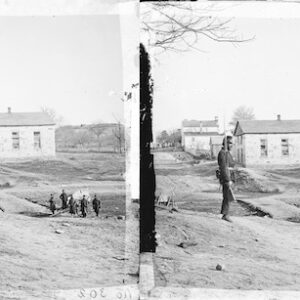| Credit: | by Barnard & Gibson |
|---|---|
| Date: | 1862.03 |
| Negative Size: | 8 in. x 10 in. |
| Equipment: | bayonet; cap box; long gun |
| Locations & Lines: | Centreville VA; Virginia |
| Military Units: | Army of the Potomac; US Army |
| Structures & Establishments: | Stone Church (Centreville VA) |
| Transports: | horse-drawn cart |
| Sources: | Library of Congress; National Archives; USAMHI – MOLLUS collection |
$5.99
File Details: AIKUm, 600 DPI, TIFF, Original Photograph, 22.4 Mb
Image ID: AIKU
Gardners Photographic Sketch Book Of The War. Vol. 1, No. 4. Stone Church, Centreville, Va. March, 1862. Perched upon the gentle slope of the ridge that bears its name, and looking across fertile fields to the mountains that rise up grandly hiding the West, Centreville had smiled on many generations, and grown feeble with all its pleasant things about it. The houses were leaning structures with huge stone chimneys, doors that creaked in their old age, and fences that straggled every way, but there was always an odor of wild roses and honey-suckle about it, and a genial hospitality to welcome the stranger. War crushed it, piled earthworks upon its ruins to protect hostile camps, built cantonments in its gardens, and made hospitals of the churches. Scarcely a vestige of its former self remains. Redoubts and riflepits stretch along its knolls; graves, half hidden by the grass, tell where the dead of both armies slumber, and the spot now only interests the visitor because of the wreck that has come upon it. Here the divisions of McDowell gathered strength after their weary march to assault the position of the enemy, and here his rear-guard checked the returning tide of half-beaten Confederates. Pope next sought it as a rock of strength in his fierce struggle back from Cedar Mountain, and again, in 1863, Meade turned his columns towards its ridges for a bulwark to defend the Capital. Guerillas have swarmed about it, cavalry have charged over its untilled fields, and demoralized divisions have bivouaced for roll-call behind its hills.
Through all these scenes a few of its people have lived and suffered, faithful to their homes. Others are turning back from uncertain wanderings to the resting place of their fathers, and, with returning peace, the husbandman finds that nature has not forgotten its fruitfulness in the years of war and devastation.


